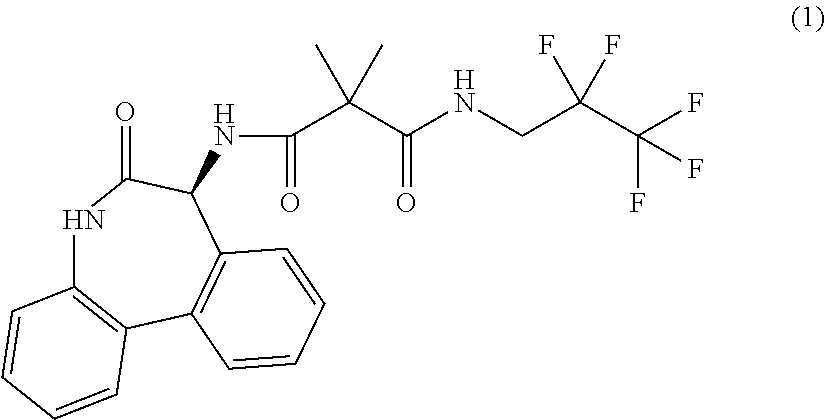Method of treating non-small cell lung cancer and colon cancer with gamma-secretase inhibitor
a non-small cell lung cancer and gamma secretase inhibitor technology, applied in the direction of biocide, drug composition, peptide/protein ingredients, etc., can solve the problems of poor prognosis, high tumor recurrence and metastases associated with poor survival rate, and the clinical benefit achieved with most of the currently available anticancer drugs is limited
- Summary
- Abstract
- Description
- Claims
- Application Information
AI Technical Summary
Problems solved by technology
Method used
Image
Examples
example 1
Breadth of Antitumor Activity of Once Daily Oral Administration of Compound (1) in Human Tumor Xenografts in Nude Mice
[0048]In a previous antitumor efficacy study, when compound (1) was administered orally to mice bearing A549 non-small cell lung carcinoma (NSCLC) xenografts, doses of 3, 10, or 30 mg / kg given once or twice daily for 14 (14+ / 7−) or 21 days resulted in significant and sustained tumor growth inhibition, with % tumor growth inhibitions (TGIs) ranging from 66-83% as compared to vehicle treated control animals. Once daily administration of compound (1) was as efficacious as twice daily treatments with either the 14+ / 7− or 21 day treatment schedule without dose dependency. Moreover, a shorter dosing duration (14+ / 7−) was as effective in inhibiting A549 tumor growth as dosing for a full 21 days.
[0049]To investigate the breadth of antitumor activity of compound (1), four additional efficacy studies were conducted in two colorectal cancer (Lovo and HCT116) and two non-small c...
example 2
Cellular Activity of Compound (1) in A549 NSCLC Tumor Cells
[0081]Compound (1) IC50 in cellular and cell-free assays is in the low nanomolar range with a >2 log unit selectivity observed with respect to 75 other binding sites of various types (receptors, ion channels, enzymes). The growth inhibitory activity of compound (1) is complex. Compound (1) does not block tumor cell proliferation nor induce apoptosis but instead produces a less transformed more flattened slower growing phenotype. This mechanism is consistent with Notch inhibition and precludes collecting standard EC50 values. Compound (1) reduces Notch processing as measured by the reduction in ICN expression by Western blot. This leads to reduced expression of the transcriptional target gene product, Hes1, also measured by Western blot.
[0082]During development and tissue remodeling, pluripotent stem cells serve as the source for differentiating cells to give rise to non-proliferating specialized cell types. A link between th...
example 3
A549 Xenograft Western Blot Analysis Following Compound (1) Dosing
[0094]Compound (1) is a potent and selective inhibitor of γ-secretase producing inhibitory activity of Notch signaling in tumor cells (1). Compound (1) IC50 in cellular and cell-free assays is in the low nanomolar range with a >2 log unit selectivity observed with respect to 75 other binding sites of various types (receptors, ion channels, enzymes). The growth inhibitory activity of compound (1) is complex. Compound (1) does not block tumor cell proliferation nor induce apoptosis but instead produces a less transformed more flattened and slower growing phenotype. This mechanism is consistent with Notch inhibition. Compound (1) treated tumors have reduced level of the extracellular matrix proteins collagen type 5 and elevated levels of MFAP5. In addition, Notch processing is inhibited in the tumor cells as measured by the loss of ICN and Notch-1 receptor expression. When mice bearing A549 xenografts were dosed up to 60...
PUM
| Property | Measurement | Unit |
|---|---|---|
| volume | aaaaa | aaaaa |
| volumes | aaaaa | aaaaa |
| temperature | aaaaa | aaaaa |
Abstract
Description
Claims
Application Information
 Login to View More
Login to View More - R&D Engineer
- R&D Manager
- IP Professional
- Industry Leading Data Capabilities
- Powerful AI technology
- Patent DNA Extraction
Browse by: Latest US Patents, China's latest patents, Technical Efficacy Thesaurus, Application Domain, Technology Topic, Popular Technical Reports.
© 2024 PatSnap. All rights reserved.Legal|Privacy policy|Modern Slavery Act Transparency Statement|Sitemap|About US| Contact US: help@patsnap.com










